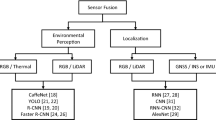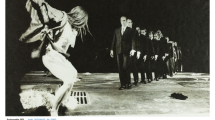Abstract
Artificial Intelligence (AI) has received considerable attention in recent years, especially because of the impressive advances in machine learning. In this chapter, I will start by clarifying the term AI from a research perspective and present some of the great successes of AI in the last 20 years. Then I will turn to the importance of AI for the realization of Industry 4.0 with a focus on production technology. In this context, I will address the promises and challenges raised by machine learning methods, but also why other areas of AI such as automated planning can play an important role. The discussion will be illustrated with examples from current research.
Access this chapter
Tax calculation will be finalised at checkout
Purchases are for personal use only
Similar content being viewed by others
Notes
- 1.
A concise history of AI can be found in the textbook by Russell and Norvig (2016), which has long served as a reference for teaching AI at universities worldwide.
- 2.
GPU stands for Graphics Processing Unit. As the name suggests, these were originally developed for computer graphics applications and allow highly parallel computations.
- 3.
As an indication of the importance of this field, the American Defense Advanced Research Project Agency (DARPA) initiated a special funding program (https://www.darpa.mil/program/explainable-artificial-intelligence).
- 4.
At the beginning, the focus of Robocup (www.roborcup.org) was to develop soccer playing robots. In the meantime, many other fields are considered such as rescue or service robots in the home, and more recently, robots in industrial settings such as production logistics.
- 5.
The Carologistics Team, a collaboration between RWTH Aachen University and The University of Applied Science Aachen, has already won the world title in the RCLL several times.
- 6.
The Int. Conf. on Automated Planning and Scheduling (ICAPS) not only showcases the latest research results in AI planning but also regularly holds competitions, where state-of-the-art planning systems compete against each other using benchmarks from a wide range of domains.
- 7.
An example is the technology behind voice-controlled personal assistants, which have become part of our daily lives already.
References
Bambach M, Seuren S (2015) On instabilities of force and grain size predictions in the simulation of multi-pass hot rolling processes. J Mater Process Technol 216, Elsevier, pp 95–113
Bonet B, Geffner H (2013) A concise introduction to models and methods for automated planning. Synthesis lectures on artificial intelligence and machine learning. Morgan Claypool Publishers
Brenner M, Nebel B (2009) Continual planning and acting in dynamic multiagent environments. Autonomous Agents Multi-Agent Syst 19(3):297–331
Brown N, Sandholm T (2019) Superhuman AI for multiplayer poker. Science 365(6456):885–890
Ferrucci DA, Brown EW, Chu-Carroll J, Fan J, Gondek D, Kalyanpur A, Lally A, Murdock JW, Nyberg E, Prager JM, Schlaefer N, Welty CA (2010) Building Watson: an overview of the DeepQA Project. AI Magazine 31(3):59–79
Fox D, Burgard W, Thrun S, Cremers AB (1998) A hybrid collision avoidance method for mobile Robots. In: IEEE International Conference on Robotics and Automation (ICRA), pp 1238–1243
Hofmann T, Niemueller T, Claßen J, Lakemeyer G (2016) Continual Planning in Golog. In: Thirtieth AAAI Conference on Artificial Intelligence, pp 3346–3353
Hofmann T, Niemueller T, Lakemeyer G (2017) Initial results on generating macro actions from a plan database for planning on autonomous mobile Robots. Int Conf Automat Plan Sched:498–503
Hönig W, Satish Kumar TK, Cohen L, Ma H, Xu H, Ayanian N, Koenig S (2016) Multi-agent path finding with kinematic constraints. In: International Conference on Automated Planning and Scheduling (ICAPS), pp 477–485
Hopmann C, Jescke S, Meisen T, Thiele TD, Tercan H, Liebenberg M, Heinisch J, Theunissen M (2017) Combined learning processes for injection molding based on simulation and experimental data. In: 33rd International Conference of the Polymer Processing Society (PPS-33)
Krizhevsky A, Sutskever I, Hinton GE (2017) ImageNet classification with deep convolutional neural networks. Commun ACM 60(6):84–90
Kusiak A, Chen M (1988) Invited review: expert systems for planning and scheduling manufacturing systems. Eur J Operat Res 34(2):113–130
LeCun Y, Bengio Y, Hinton G (2017) Deep learning. Nature 521:436–444
Leofante F, Ábrahám E, Niemueller T, Lakemeyer G, Tacchella A (2017) On the synthesis of guaranteed-quality plans for Robot Fleets in logistics scenarios via optimization modulo theories. In: IEEE International Conference on Information Reuse and Integration, pp 403–410
Meyes R, Tewrcan H, Thiele T, Krämer A, Heinisch J, Liebenberg M, Hirt G, Hopmann C, Lakemeyer G, Meisen T, Jeschke S (2018) Interdisciplinary data driven production process analysis for the internet of production. In: 46th SME North American Manufacturing Research Conf. (NAMRC 46), Elsevier
Monostori I, Markus A, Van Brussel H, Westkämpfer E (1996) Machine learning approaches to manufacturing. CIRP Ann Manufact Technol 45(2):675–712
Niemueller T, Ewert D, Reuter S, Ferrein A, Jeschke S, Lakemeyer G (2016) Robocup logistics league sponsored by festo: a competitive factory automation testbed. In: Jeschke S, Isenhardt I, Hees F, Henning K (eds) Automation, communication and cybernetics in science and engineering 2015/2016. Springer, Cham, pp 605–618
Ribeiro MT, Singh S, Guestrin C (2016) Why should I Trust You? Explaining the Predictions of any Classifier. In: Proceedings of the 22nd ACM SIGKDD, pp 1135–1144
Roberts M, Lford R, Shivashankar V, Leece M, Gupta S, Aha DW (2016) ACTORSIM: A toolkit for studying goal reasoning, planning, and acting. In: Workshop on Planning and Robotics (PlanRob) at International Conference on Automated Planning and Scheduling (ICAPS)
Russell S, Norvig P (2016) Artificial intelligence: a modern approach, Global edn. Pearson
Schäpers B, Niemueller T, Lakemeyer G, Gebser M, Schaub T (2018) ASP-based time-bounded planning for logistics robots. In: International Conference on Automated Planning and Scheduling (ICAPS), pp 509–517
Shen W (2002) Distributed manufacturing scheduling using intelligent agents. IEEE Intell Syst 17(1):88–94
Silver D, Huang A, Maddison CJ, Guez A, Sifre L, van den Driessche G, Schrittwieser J, Antonoglou I, Panneershelvam V, Lanctot M, Dieleman S, Grewe D, Nham J, Kalchbrenner N, Sutskever I, Lillicrap TP, Leach M, Kavukcuoglu K, Graepel T, Hassabis D (2016) Mastering the game of Go with deep neural networks and tree search. Nature 529(7587):484–489
Thrun S (2006) A personal account of the development of Stanley, the Robot that Won the DARPA grand challenge. AI Magazine 27(4):69–82
Thrun S, Burgard W, Fox D (2005) Probabilistic Robotics. MIT Press
Zwilling F, Niemueller T, Lakemeyer G (2014) Simulation for the RoboCup Logistics League with real-world environment agency and multi-level abstraction. RoboCup Symposium, Springer LNCS, pp 220–232
Author information
Authors and Affiliations
Corresponding author
Editor information
Editors and Affiliations
Rights and permissions
Copyright information
© 2022 Springer-Verlag GmbH Germany, part of Springer Nature
About this chapter
Cite this chapter
Lakemeyer, G. (2022). Artificial Intelligence 4.0. In: Frenz, W. (eds) Handbook Industry 4.0. Springer, Berlin, Heidelberg. https://doi.org/10.1007/978-3-662-64448-5_36
Download citation
DOI: https://doi.org/10.1007/978-3-662-64448-5_36
Published:
Publisher Name: Springer, Berlin, Heidelberg
Print ISBN: 978-3-662-64447-8
Online ISBN: 978-3-662-64448-5
eBook Packages: Law and CriminologyLaw and Criminology (R0)




